Intel Thunderbolt 4 Update: Controllers and Tiger Lake in 2020
by Dr. Ian Cutress on July 8, 2020 9:00 AM EST- Posted in
- CPUs
- Tiger Lake
- USB4
- Thunderbolt 4
- TB4

Wired connectivity is converging onto two standards: USB4 and Thunderbolt 4. Both of these are set to debut by the end of the year in Intel’s upcoming Tiger Lake platform, and to set the scene Intel is updating us on the scope of its Thunderbolt 4 efforts.
Thunderbolt 4 is going to be a superset of TB3 and USB4, meaning that any Thunderbolt 4 Type-C host will be able to accept TB4, TB3, USB4, and USB 3/2/1 connections. Thunderbolt 4 will offer speeds up to 40 Gb/s, and there are a number of requirements for Thunderbolt 4 hosts and devices in order to be certified.
These requirements include:
- Video, support 2x 4K or 1x 8K (No detail at what refresh/bit-rate/chroma)
- Data, PCIe at 32 Gbps (storage up to 3 GB/s)
- Support for TB4 docks with four TB4 ports (one upstream, 3 downstream)
- PC Charging on at least one port (for laptops up to 100 W)
- Wake from sleep by peripherals connected to a TB4 dock
- Requires Direct Memory Access protection (more on this later)
The first devices to come to market with TB4 support will be Intel’s Tiger Lake platform, for use in laptops, which will have TB4 baked right into the silicon. TB4 will be one of the base requirements for Intel’s Project Athena certification program, and Intel is set to release a new TB4 2m cable for most use cases. Intel is also working on optical 5-50 meter cables, which will also now support the TB4 multi-port accessory architecture, enabled by 4-port TB4 hubs.
There will be two host controllers, known as Maple Ridge JHL8540 and JHL8340, for use as host controllers in desktops, workstations, and laptops. We are told the package size and power requirements are essentially in-line with previous Titan Ridge TB3 controllers. The device controller, for use in docks, monitors, storage devices and such, is the Goshen Ridge JHL8440. All three of these controllers will be available by the end of the year.
Thunderbolt 4 has no costs associated with using it, the branding, or the logo, however there is a branding/logo license. Intel has opened up the TB4 standard, but as it stands is the only company that has publically announced its intention to make host and device controllers. The cables will be branded with the Thunderbolt Logo and a number 4, however ports on systems will only have the Thunderbolt Logo, making TB3 and TB4 use indistinguishable (we disagree with Intel that users don’t check what their system uses so using the same logo makes no difference to these users – we think the same argument can be used in order to showcase the logo on devices with the number 4).
Here’s a main slide showcasing the difference between all the different standards. Ultimately TB4 is backwards compatible with TB3 and USB4/3/2/1 standards.
One of the key focal points in our briefings with Intel is that Thunderbolt 4 will have an additional requirement this time round – Direct Memory Access protection to prevent physical attacks. In our briefing (and shown on the slide below), Intel initially stated that this requires Intel VT-d technology, which raised questions about Thunderbolt 4 being limited to Intel only systems.
The spokesperson later clarified that in order to gain certification, DMA protection is required, and Intel is using VT-d to do it. Intel refused to comment on how other vendors might implement DMA protection, stating that it would be up to them. While additional security protections are always a good thing, they ideally need to be based around open vettable standards, something which might limit Thunderbolt for another generation as an Intel-only technology (whereas USB is far more ubiquitous).
We’ve reached out to AMD late in the day, and they’ll be supplying a comment soon. I will update this post when I get something.
Update, AMD says the following:
The “Zen 2” architecture supports DMA security in pre-boot and OS environments via AMD-Vi (IOMMU) on USB and PCIe interfaces.
When asked specifically if AMD-Vi meets the requirements for TB4, AMD stated:
If the question is to do we support DMA? The answer is yes. Any questions about if this would satisfy another companies requirements for an interface they are developing would need to be directed at them.
When we asked Intel to confirm if AMD-Vi met the requirements for TB4's DMA protection, we were given the following quote:
Thunderbolt is open to non-Intel-based systems. Like any other system, devices must pass Thunderbolt certification and end-to-end testing conducted by third-party labs. Thunderbolt 4 requirements include Intel VT-d based or an equivalent DMA protection technology that provides IO virtualization (often referred to as IO Memory Management Unit or IOMMU), as well as OS implementation support. If the equivalent technology supports prevention against physical attacks, then that should meet the requirement.
Overall, TB4 seems like a very capable standard, providing backwards compatibility, top class speeds, as well as new connectivity topologies. It will be interesting to see what the additional cost of adding TB4 onto various systems will be with Intel’s controllers, especially in the desktop space.



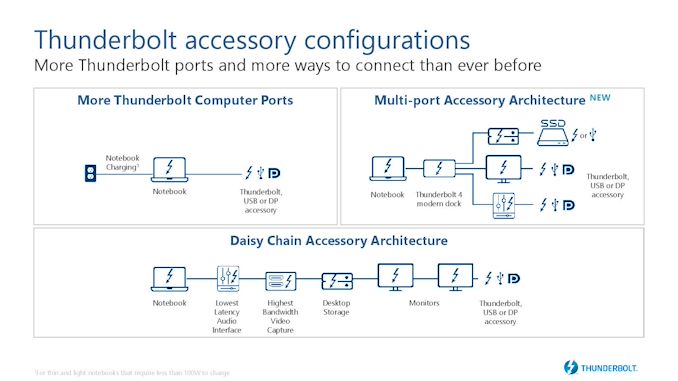
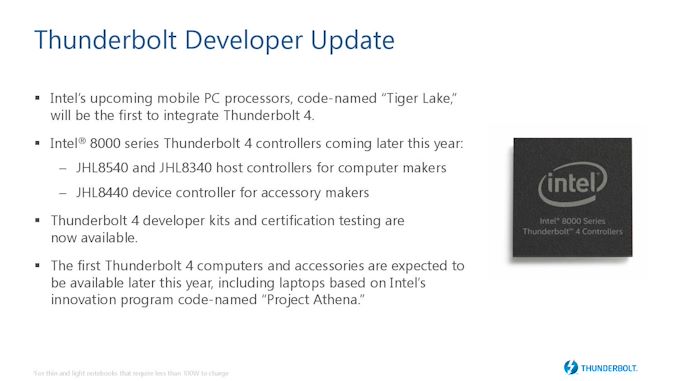

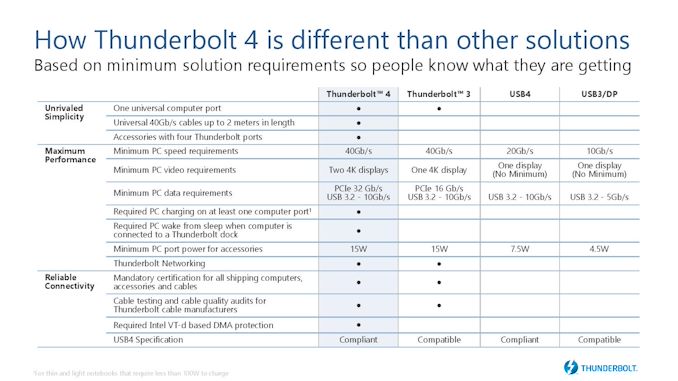
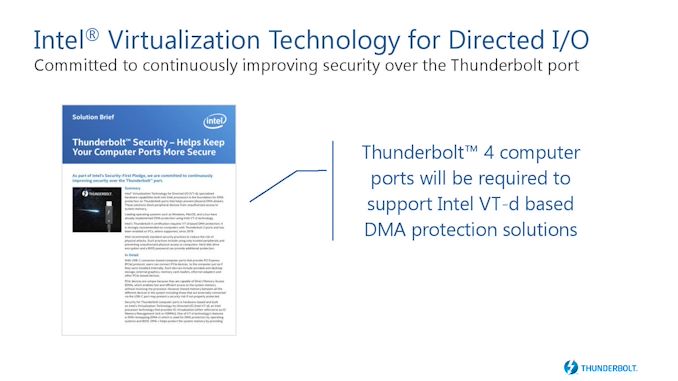
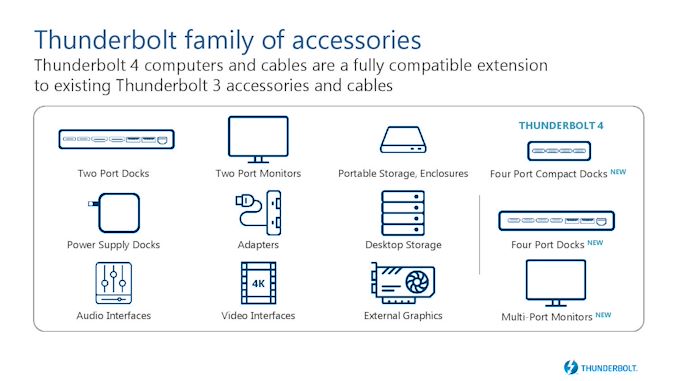














76 Comments
View All Comments
Mr Perfect - Wednesday, July 8, 2020 - link
This is cool tech, so hopefully the OEMs actually put some TB4 ports on things. It's been about six years since USB-C rolled out and we're still getting between 0 and 1 ports of that.tipoo - Wednesday, July 8, 2020 - link
Why does it require twice the host bandwidth when the TB bandwidth is the same?repoman27 - Wednesday, July 8, 2020 - link
I believe the first comment in this thread pretty much answers you question—because OEMs sometimes used PCIe Gen 3 x2 links or only a single DisplayPort stream for Thunderbolt 3 controllers. So now with Thunderbolt 4, you need to provide each host controller a minimum of a PCIe Gen 3 x4 link and two DisplayPort main links capable of HBR2.31.5 Gbit/s of PCIe and 34.56 Gbit/s of DisplayPort data seems like a perfectly reasonable requirement for the back end of a controller that enables two downstream ports at 40 Gbit/s each.
FAdamsXII - Wednesday, July 8, 2020 - link
What good is an open hardware standard that requires use of a proprietary closed "standard" to be able to use it? Thunderbolt 3 is touchy enough as it is, and while most of this seems like it'll reduce complexity, requiring use of a proprietary standard that IIRC is patented by Intel while pretending anyone can use it and its an open standard is typically Intel, and that's not meant as a compliment.They wonder why their semi-proprietary products like Optane don't really go anywhere, but parading around hardware that isn't open while pretending that it is might have a lot to do with that.
repoman27 - Thursday, July 9, 2020 - link
While I'm with you on the feeling that this is only a veneer of openess and typically Intel, the USB4 specification is freely available and that more or less includes the Thunderbolt 3 protocol.All you need to do is sign the USB4 Adopters Agreement and you get access to a royalty-free reasonable and nondiscriminatory license from the Promoters and other Adopters to certain standard essential IP. You'll also need to sign the USB 3.0 and USB 2.0 Adopters Agreements, but those are also reciprocal, royalty-free licensing arrangements for compliant products.
If you demonstrate compliance with the specs through the USB-IF testing program you are granted certain rights to use the USB-IF logos.
If you complete certification and execute a Thunderbolt trademark license with Intel you can use the Thunderbolt trademark or logo on your product.
You'll probably also need to become a VESA member to access the DisplayPort specs, and they do charge a membership fee based on annual sales revenue, however there are no royalties or licensing fees associated with their standards.
So really it comes down to how much of a minefield developing your own USB4 / Thunderbolt IP ends up being. Honestly I don't expect anyone outside of Apple and maybe Asmedia or AMD to bother.
hubick - Thursday, July 9, 2020 - link
I spent a lot of money on a 2TB Samsung X5 Thunderbolt 3 external SSD, which I can now no longer use on my new Threadripper system. Intel can shove any standard that doesn't have regular add-in cards that work on AMD systems. I won't fall for their proprietary crap again, no matter how fast it is.Valantar - Friday, July 10, 2020 - link
There are ways to make any TB3 AIC work on any system, IIRC you just need to short two pins on the connector for the cable that would connect to the motherboard. Last I read hot-swap was a bit iffy with this workaround, though that's several years ago.Kamen Rider Blade - Thursday, July 9, 2020 - link
Yet there still isn't a speed improved variant.Kill the last wires used for USB 2.0 backward compatibility and turn those into the 3rd set of Full Duplex lanes.
It's been done as a Alt mode already by another group.
Just make it official and kill off USB 2.0 support within the cable.
Bandwidth is more important and TB4 / USB4 should be pushing for more speed.
ET - Thursday, July 9, 2020 - link
I might be misunderstanding something, but wouldn't a USB 4 40 cable cover all the other standards as well?vortmax2 - Thursday, July 9, 2020 - link
"The first devices to come to market with TB4 support will be Intel’s Tiger Lake platform, for use in laptops, which will have TB4 baked right into the silicon."Does this mean ALL laptops with the Tiger Lake will actually have TB4 or is there other things manufacturer need to do for enablement?